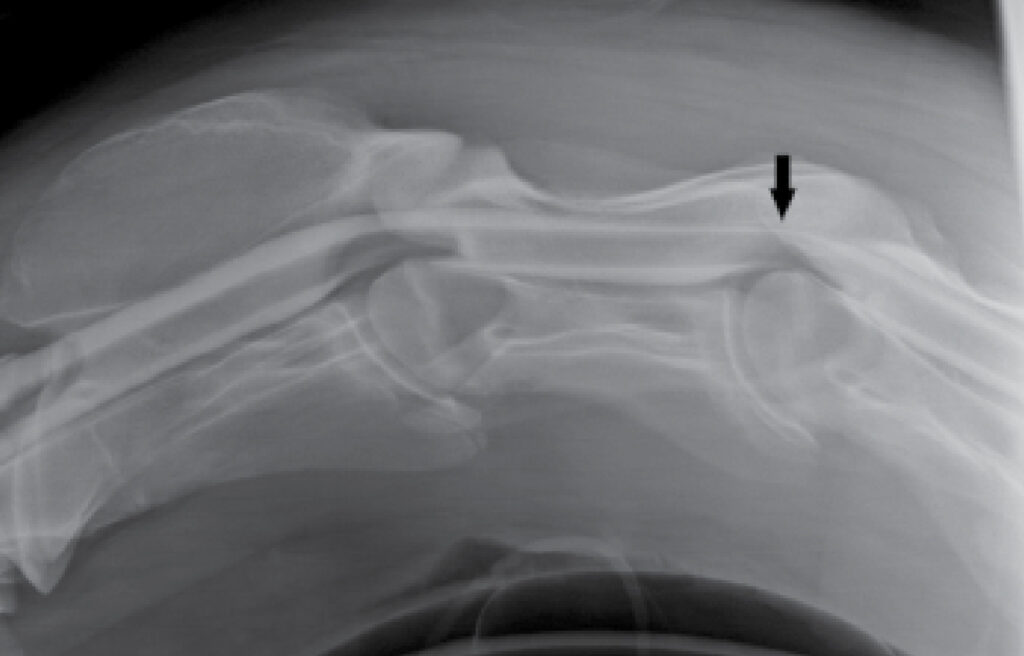Today’s path rounds are on 𝐖𝐨𝐛𝐛𝐥𝐞𝐫𝐬 𝐬𝐲𝐧𝐝𝐫𝐨𝐦𝐞! This was a request!
𝐖𝐡𝐚𝐭 𝐢𝐬 𝐢𝐭?
Wobblers syndrome’s proper name is 𝐜𝐞𝐫𝐯𝐢𝐜𝐚𝐥 𝐯𝐞𝐫𝐭𝐞𝐛𝐫𝐚𝐥 𝐬𝐭𝐞𝐧𝐨𝐭𝐢𝐜 𝐦𝐲𝐞𝐥𝐨𝐩𝐚𝐭𝐡𝐲, and it is a common cause of 𝐚𝐭𝐚𝐱𝐢𝐚 (irregular gait due to neurologic issues) in horses. The main problem in Wobblers is compression of the spinal cord due to an irregular shape or positioning of 𝐜𝐞𝐫𝐯𝐢𝐜𝐚𝐥 𝐯𝐞𝐫𝐭𝐞𝐛𝐫𝐚𝐞 (the bones in the neck).
𝐖𝐡𝐨 𝐠𝐞𝐭𝐬 𝐢𝐭?
Both dogs and horses can get this condition, but today we are going to focus on the ponies!
𝐖𝐚𝐢𝐭, 𝐰𝐡𝐚𝐭 𝐚𝐫𝐞 𝐭𝐡𝐞 𝐭𝐲𝐩𝐞𝐬?
There are two basic types of Wobblers! Type I primarily affects young horses, and typically has 𝐝𝐲𝐧𝐚𝐦𝐢𝐜 𝐜𝐨𝐦𝐩𝐫𝐞𝐬𝐬𝐢𝐨𝐧 in this type of Wobblers. This means that the spinal cord is only compressed when the neck is flexed. There’s a few things that can cause this, including a poorly shaped vertebra from birth, enlargement of the growth plates, or having vertebrae that are misaligned. All of these problems can lead to some part of the bony structure of the vertebrae squishing the spinal cord when the neck is bent.
Type II primarily affects older horses, and typically has 𝐬𝐭𝐚𝐭𝐢𝐜 𝐜𝐨𝐦𝐩𝐫𝐞𝐬𝐬𝐢𝐨𝐧. This means that the spinal cord is always compressed, regardless of whether the neck is flexed or not. Typically this is caused by arthritic changes in the vertebral column, leading to formation of 𝐨𝐬𝐭𝐞𝐨𝐩𝐡𝐲𝐭𝐞𝐬 (boney nodules) or other malformations that can compress the spinal cord.
𝐖𝐡𝐚𝐭 𝐚𝐫𝐞 𝐭𝐡𝐞 𝐫𝐢𝐬𝐤 𝐟𝐚𝐜𝐭𝐨𝐫𝐬?
Type I Wobblers has a lot of risk factors, including inheritance, the diet the horse was fed, trauma or having a fast rate of growth. So it is very important to speak to your veterinarian about appropriate nutrition for your young horses, to help prevent these types of conditions! Beyond that, both types of Wobblers are primarily found in Thoroughbreds and Warmbloods, and typically affect male horses.
𝐇𝐨𝐰 𝐢𝐬 𝐢𝐭 𝐝𝐢𝐚𝐠𝐧𝐨𝐬𝐞𝐝?
To help diagnose this condition, the veterinarian will complete a 𝐧𝐞𝐮𝐫𝐨𝐥𝐨𝐠𝐢𝐜 𝐞𝐱𝐚𝐦, a series of tests designed to help the veterinarian figure out where the horse’s neurological issues are coming from. On this exam, the veterinarian might see weakness with toe-dragging or scuffing, and an irregular gait that is worse in the hind limbs than the front limbs. In general, the signs will affect both sides of the horse equally. Horses may trip or stumble frequently, and generally do not seem to know where their legs are at any given moment. When standing, some horses might have a wide stance.
After the veterinarian has done the neurologic exam, they might proceed to taking X-rays of the neck to see if there are any obvious abnormalities. If they are at a referral or specialty center, they may also do a special kind of X-ray called a 𝐦𝐲𝐞𝐥𝐨𝐠𝐫𝐚𝐦, which is where they put a liquid into the spinal canal that is 𝐫𝐚𝐝𝐢𝐨–𝐨𝐩𝐚𝐪𝐮𝐞, meaning that it will show up as white on the X-ray. This liquid helps the clinician visualize where the compression points are occurring, or if they’re even present at all. Horses can also have flexed myelograms completed, to assess dynamic compression like in Type I Wobblers.
𝐇𝐨𝐰 𝐢𝐬 𝐢𝐭 𝐭𝐫𝐞𝐚𝐭𝐞𝐝?
For young horses showing early signs of Wobblers, management is focused on adjusting the diet to reduce their rate of growth and reduce risk factors. Adult horses showing signs of arthritis can have the vertebral joints injected to help reduce inflammation and swelling, and slow the progression of arthritis. Some horses may be eligible for a surgical procedure, where an implant called a 𝐁𝐚𝐠𝐛𝐲 𝐛𝐚𝐬𝐤𝐞𝐭 is placed. The purpose of this implant is to 𝐟𝐮𝐬𝐞 the vertebral joint (prevent it from flexing or moving), to reduce the compression of the spinal cord.
𝐏𝐡𝐨𝐭𝐨𝐬
1) A beautiful diagram I made of the different types of compression (they don’t pay me to make art, people).
2) A myelogram showing static compression of the spinal cord.
3) A myelogram showing dynamic compression of the spinal cord.
4) An X-ray after placement of Bagby baskets.
5) An example of static compression at necropsy.
6) An example of dynamic compression at necropsy.
𝐒𝐨𝐮𝐫𝐜𝐞𝐬
Johnson, A.L., Reed, S. Cervical Vertebral Stenotic Myelopathy. Equine Neurology, Second Edition 2015.
Photos 2-4 courtesy of Johnson and Reed.
Photo 5-6 courtesy of Noah’s Arkive.










